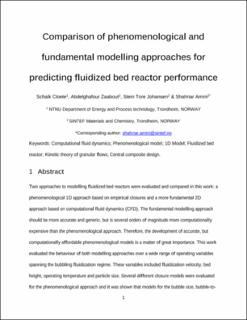| dc.contributor.author | Cloete, Schalk | |
| dc.contributor.author | Zaabout, Abdelghafour | |
| dc.contributor.author | Johansen, Stein Tore | |
| dc.contributor.author | Amini, Shahriar | |
| dc.date.accessioned | 2020-12-14T11:10:33Z | |
| dc.date.available | 2020-12-14T11:10:33Z | |
| dc.date.created | 2012-10-02T13:16:31Z | |
| dc.date.issued | 2012 | |
| dc.identifier.citation | Powder Technology. 2012, 228 69-83. | en_US |
| dc.identifier.issn | 0032-5910 | |
| dc.identifier.uri | https://hdl.handle.net/11250/2719120 | |
| dc.description.abstract | Two approaches to modelling fluidized bed reactors were evaluated and compared in this work: a phenomenological 1D approach based on empirical closures and a more fundamental 2D approach based on computational fluid dynamics (CFD). The fundamental modelling approach should be more accurate and generic, but is several orders of magnitude more computationally expensive than the phenomenological approach. Therefore, the development of accurate, but computationally affordable phenomenological models is a matter of great importance. This work evaluated the behaviour of both modelling approaches over a wide range of operating variables spanning the bubbling fluidization regime. These variables included fluidization velocity, bed height, operating temperature and particle size. Several different closure models were evaluated for the phenomenological approach and it was shown that models for the bubble size, bubble-to-emulsion mass transfer coefficient and solids inside the bubble all have a significant impact on model performance. An optimal combination of closure models used in the phenomenological approach succeeded in providing a good match to data gathered from the more generic fundamental approach. The response of the model to changes in particle size was identified as the area with the greatest potential for further development. More detailed comparisons of axial distributions of important flow variables showed some differences between the predictions of the phenomenological and fundamental modelling approaches. In particular, the hydrodynamic measures of axial void distribution and bubble rise velocity predicted by these two approaches showed some significant differences. | en_US |
| dc.language.iso | eng | en_US |
| dc.publisher | Elsevier | en_US |
| dc.rights | Attribution-NonCommercial-NoDerivatives 4.0 Internasjonal | * |
| dc.rights.uri | http://creativecommons.org/licenses/by-nc-nd/4.0/deed.no | * |
| dc.subject | Central composite design | en_US |
| dc.subject | Kinetic theory of granular flows | en_US |
| dc.subject | Fluidized bed reactor | en_US |
| dc.subject | 1D model | en_US |
| dc.subject | Phenomenological model | en_US |
| dc.subject | Computational fluid dynamics | en_US |
| dc.title | Comparison of phenomenological and fundamental modelling approaches for predicting fluidized bed reactor performance | en_US |
| dc.type | Peer reviewed | en_US |
| dc.type | Journal article | en_US |
| dc.description.version | acceptedVersion | en_US |
| dc.rights.holder | © 2012. This is the authors’ accepted and refereed manuscript to the article. This manuscript version is made available under the CC-BY-NC-ND 4.0 license http://creativecommons.org/licenses/by-nc-nd/4.0/ | en_US |
| dc.source.pagenumber | 69-83 | en_US |
| dc.source.volume | 228 | en_US |
| dc.source.journal | Powder Technology | en_US |
| dc.identifier.doi | 10.1016/j.powtec.2012.04.063 | |
| dc.identifier.cristin | 948108 | |
| dc.relation.project | Norges forskningsråd: 197580 | en_US |
| cristin.unitcode | 7401,80,5,2 | |
| cristin.unitname | Strømningsteknikk | |
| cristin.ispublished | true | |
| cristin.fulltext | postprint | |
| cristin.qualitycode | 1 | |

